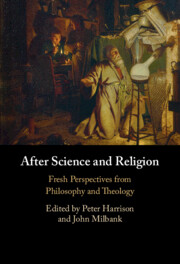Book contents
- After Science and Religion
- Reviews
- After Science and Religion
- Copyright page
- Contents
- Contributors
- Acknowledgements
- Introduction
- Part I Modern Historians on ‘Science’ and ‘Religion’
- Chapter 1 Science and Religion as Historical Traditions
- Chapter 2 The Nineteenth-Century Origins of the Problem
- Part II Beyond ‘Science and Religion’
- Part III Philosophical Problems with ‘Science’ and ‘Religion’
- Part IV Before Science and Religion
- References
- Index
Chapter 2 - The Nineteenth-Century Origins of the Problem
Naturalistic Metaphysics and the Dead Ends of Victorian Theology
from Part I - Modern Historians on ‘Science’ and ‘Religion’
Published online by Cambridge University Press: 05 May 2022
- After Science and Religion
- Reviews
- After Science and Religion
- Copyright page
- Contents
- Contributors
- Acknowledgements
- Introduction
- Part I Modern Historians on ‘Science’ and ‘Religion’
- Chapter 1 Science and Religion as Historical Traditions
- Chapter 2 The Nineteenth-Century Origins of the Problem
- Part II Beyond ‘Science and Religion’
- Part III Philosophical Problems with ‘Science’ and ‘Religion’
- Part IV Before Science and Religion
- References
- Index
Summary
In the latter half of the nineteenth century science came to be seen as providing the model for seeking truth. This led to a reorganization of all of the disciplines, including theology. We have also come to see the nineteenth century as a period in which a new set of assumptions about science and religion was introduced that continues to shape how we currently view their relationship. The appearance of Draper’s History of the Conflict between Science and Religion in 1874, in which the conflict thesis is fully developed for the first time, is no coincidence. One of the things that historians can do is open up current discussions by showing the paths not taken that were live options at one point, before new assumptions constrained and narrowed thinking. This chapter examines how scientific naturalists like T. H. Huxley attempted to constrain thinking about science and religion, how those constraints began to shape debates, and how major Christian theologians of the period responded to this development, whether through resistance or conformity.
Keywords
- Type
- Chapter
- Information
- After Science and ReligionFresh Perspectives from Philosophy and Theology, pp. 35 - 58Publisher: Cambridge University PressPrint publication year: 2022



